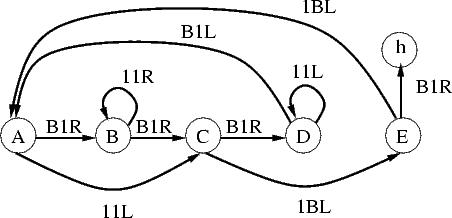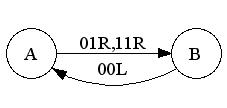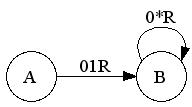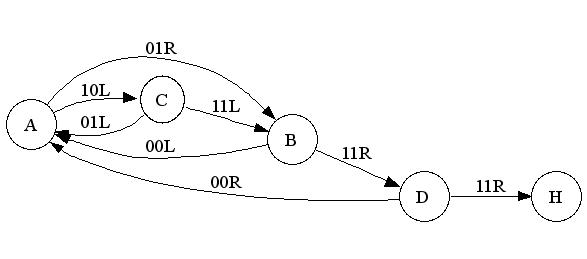Gamekeeping for the Zany Zoo: How to Hunt Busy Beavers, Placid Platypodes* and other Alliterative Animals
James Harland, School of CS&IT, RMIT
Seminar at CS&IT, RMIT University 11th August, 2006
James Harland, School of CS&IT, RMIT
Seminar at CS&IT, RMIT University 11th August, 2006
*There is no universally accepted plural for "platypus". This is one possibility; others include "platypuses", "platypode" and "platypus". The once-common "platypi" is now deprecated.
IntroductionBeaver machines are a particular type of Turing machine:
- Deterministic (at most one transition for any state and input symbol)
- Two-way infinite tape
- Tape alphabet is only blank (B) and 1
- Initially tape is entirely blank
- Single halt state
Question (placid platypus): For a given number of 1's, what is the smallest number of states required to print them by a beaver machine which halts?
Known busy beavers
- Cases n = 1,2,3 solved by Lin and Rado in 1960's
- Case n = 4 solved by Brady in 1970's
- Cases n = 5,6 had some monster machines found in 1990's and 2000's, but still open
ff(n): maximum number of state transitions made by a terminating beaver machine with n states (often written S(n))
prod(M): number of 1's printed by machine M (undefined if M does not halt)
Hence bb(n) is the maximum value of prod(M) for all n-state machines M.
Naturally ff(n) ≥ bb(n) and is typically much larger. Possible that the values of bb(n) and ff(n) arise from different machines.
| n |
bb(n) |
ff(n) |
| 1 | 1 | 1 |
| 2 | 4 | 6 |
| 3 | 6 | 21 |
| 4 | 13 | 107 |
| 5 | ≥ 4098 |
≥ 47,176,870 |
| 6 | ≥ 1.29×10865 | ≥ 3×101730 |
| 7 |
.... |
.... |
Consider that a 6-state machine can be represented in 55 bits ... (and 10865 takes about 2,800 bits)
| 3-state busy
beaver |
4-state busy beaver |
 |
 |
| 5-state busy beaver candidate | 6-state busy
beaver candidate |
 |
 |
Non-computability
The busy beaver function is non-computable, because it grows faster than any computable function!
Proof: Let f be any computable function.
f computable ⇒ so is F(x) = Σ 0 ≤ i ≤ x f(i) + i 2 ⇒ k-state machine MF : x 1's → F(x) 1's
Consider M: X then
MF
then
MF where X:
blank → x 1's. Note X has
x states.
M behaves as follows:
- M first writes x 1's
- M mimics MF , writing F(x) 1's on the tape
- M mimics MF again, writing F(F(x)) 1's on the tape
Now F(x) ≥ x 2 > x + 2k for x > m, and F(x) > F(y) when x > y, and so F(F(x)) > F(x+2k) > f(x+2k)
So bb(x+2k) ≥ x + F(x) + F(F(x)) > F(F(x)) > F(x+2k) > f(x+2k)
Hence, as f was arbitrary, bb is not computable ◊
Searching for bb(n)
How many machines are there?
- n-state machine, 2n transitions, 2 outputs, 2 directions and n+1 possible new states ⇒ (4 (n+1)) 2n
- only ever one halt state ⇒2n × (4n) 2n-1
- fix first transition (output 1, direction R, state 2, not halt) ⇒(2n-1) × (4n)2n-2
For n =5 we "only' have to search through 230,400,000,000 = 2.3 ×1011 machines ...
Naive generate and test won't work; the trick is how to incorporate the test into the generation.
| Input |
1 |
2 |
3 |
4 |
5 |
| B |
O1 = 1, D1 = R,
N1 = 2 |
not (D3 = R, N3 =
2),
N3 ≠ h |
O5, D5, N5 | O7, D7, N7 | O9, D9, N9 |
| 1 |
O2, D2, N2 |
O4, D4, N4 |
O6, D6, N6 | O8, D8, N8 | O10, D10, N10 |
Some "global" constraints can be used as well, such as avoiding N3 = 3, D3 = R, N5 = 2, D5 = R.
Tree normal form:
- emulate machine as the transitions are generated
- add the halt state only when there is only one "slot" left
- generate states in numerical order
- detect loops as early as possible
Loop detection is critical! Mining the data for the 117,440,512 machines with 4 states:
| ones |
5 |
6 |
7 |
8 |
9 |
10 |
11 |
12 |
13 |
| machines |
73,617 |
13,029 | 1981 |
475 |
79 |
13 |
6 |
5 |
2 |
- 89,207 machines terminate and print at least 5 1's
- only 2,561 machines terminate and print more 1's than the 3-state busy beaver
- loops abound!
| Machine |
Description |
Diagram |
| ignoble iguana | can be ignored in the search |  |
| perennial pigeon | repeats a configuration |  |
| road runner | moves to infinity |  |
| phlegmatic phoenix | makes tape blank |  |
| meandering meerkat | cannot execute halt transition |  |
| dizzy duck | "travelling loop" |  |
What about remaining cases?
 .... 11{C}1 → ... 11{C}111 →
... 11{C}11111 ...
.... 11{C}1 → ... 11{C}111 →
... 11{C}11111 ... Form conjecture that 11{C} 1 (11)N → 11{C} 111(11)N
Then compute from state 11{C} 1 (11)N to state 11{C}
111(11)N on hypothetical engine
To compute with L {S} INR:
- {S}IX → O{S}X --- can directly transform L {S} INR to L ON {S} R wild wombat
- L {S}IX → NewL {S}X --- make this L2.L1 {S}INR to L2.(L3)N.L1 {S} R slitering snake
- L {S}I IN R → NewL {S} IN NewR --- make this L2.L1 {S}INR to L2.(L3)N.L1 {S} I NewR maniacal monkey
- currently about 5,000 lines of Ciao Prolog ( around half of which is redundant)
- will be cleaned up and published by the end of August
- close to naive emulation seems fine
- can do all 5-state monsters within about 1 minute at worst
- wild wombat, slithery snake and manical monkey all implemented (but last one may be still a little buggy)
| Name | States | Machines | Status |
| Blue Bilby | 3 | 1,720 | 24 wild wombats, 2 slithery snakes |
| Ebony Elephant | 4 | 278,570 | some maniacal monkeys, some killer kangaroos and monster dizzy ducks, 53 machines unclassified |
| White Whale | 5 | 69,471,096 | monsters abound |
| Demon Duck of Doom | 6 | ??? | need better weapons |
Killer Kangaroo
 16{D}0 →... 118{D}0 → ... 142{D}0 → ... 190{D}0 → ...
16{D}0 →... 118{D}0 → ... 142{D}0 → ... 190{D}0 → ...
Conjectures are simple enough, but the hypothetical engine needs work ...
Current State of the Placid Platypus
Machines exist for productivities 1-73, 75-83, 87-91, 99, 112, 501,
1471, 1915, 4096, 4097, 4098 with minor variants for 46, 48, 50, 75,
77, 80, 82, 90 ...
Mysteries
- Is the Ebony Elephant quest decidable?
- Is bb(5) = 4098?
- How to write a better loop detector
- How to generate proofs of non-termination from positive loop detection
- Productivity for machines which are
- contiguous (tape always of the form B1 *B)
- eager (output is only 1, never B)
- monotonic (no transitions with 1 input
and B output)
- Distribution of 5-state machines between bb(4) and bb(5)
- Range of Platypus numbers
- What is the largest continuous range which can be represented by a terminating beaver machine?
- What is the smallest number that cannot be printed by a 6-state (resp. 5-state) machine?
- Relationship to 3n+1 problem
- Constraints on tape access (cf. linear bounded automata)
- Is bb(5) = 4098?
- Solve mysteries
- Automatic drawing of machines
- WYSIWYG editor for machines
- Add features to programming suite
(stopping just short of a web browser :-)
- Publish database of 3-, 4- and 5-state machine classes
- Mine the n=5 case for an attempt on n=6 (aka the quest for the demon duck of doom)